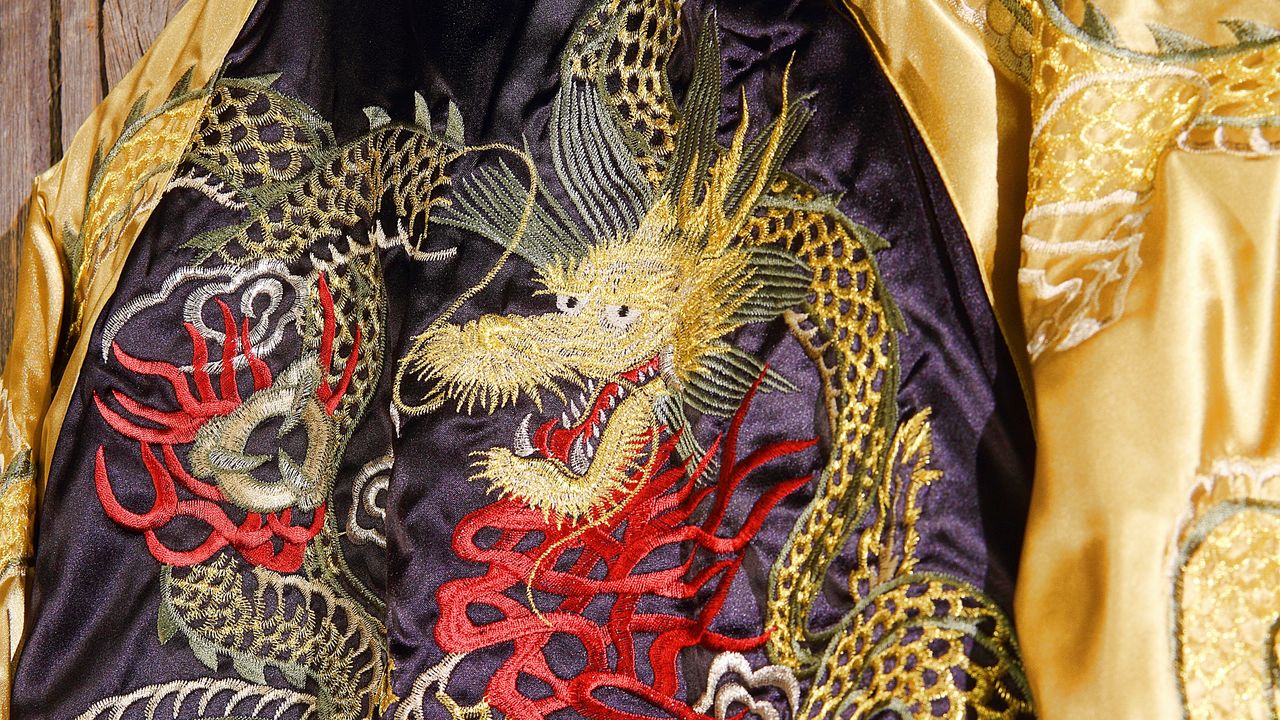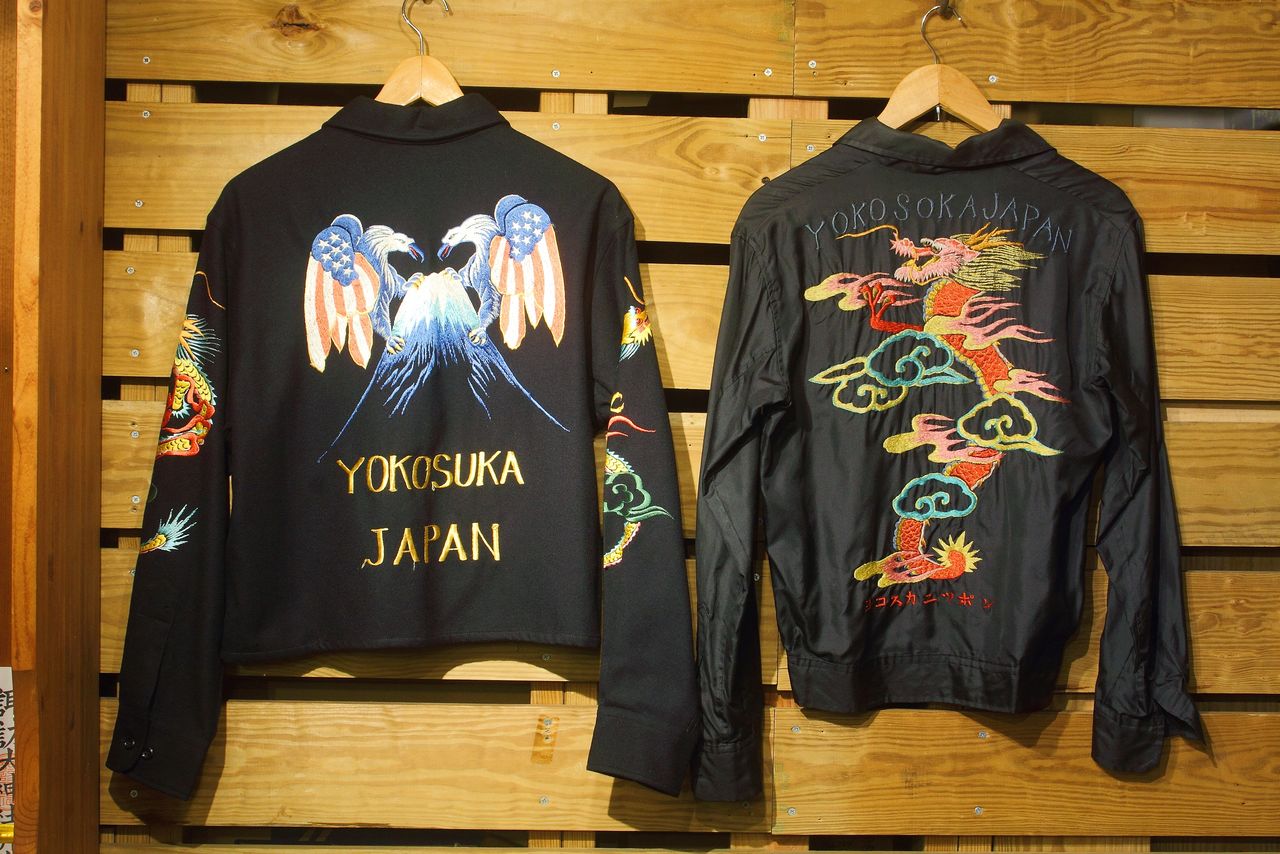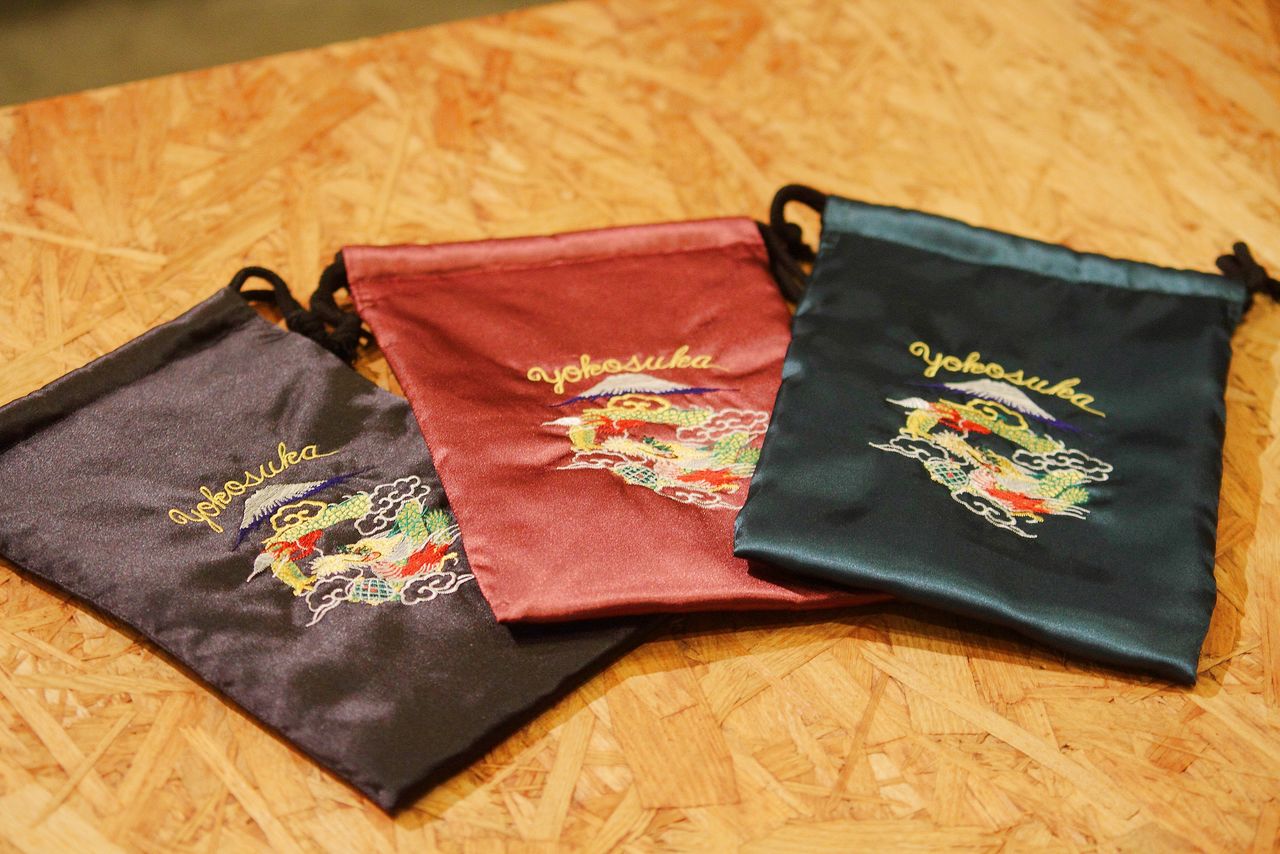
“Sukajan”: Yokosuka and the Roots of Japan’s Dazzling Bomber Jackets
Guideto Japan
Fashion Travel- English
- 日本語
- 简体字
- 繁體字
- Français
- Español
- العربية
- Русский
Yokosuka Original
Emblazoned with intricately embroidered images of fierce tigers, glowering hawks, smoldering dragons, and myriad other creatures, Japan’s iconic satin bomber jackets are eye-catching items. Known as sukajan, their distinct designs—an amalgam of Japanese and American fashion—have garnered generations of loyal fans and inspired versions by the likes of Louis Vuitton and Gucci.
Sukajan have evolved to become their own fashion genre, but their roots can be traced back to a shopping arcade in the Honchō district of Yokosuka in Kanagawa Prefecture. It was along Dobuita Street, which sits at the doorstep of a major US naval base, that “Yokosuka jumpers”—later shortened to sukajan—first appeared in the early postwar period.

Commemorative plaques identify Dobuita Street as the birthplace of sukajan. Since 2018, local retailers have joined in promoting the area’s connection to the celebrated jackets.

With a US naval base nearby, many shops and restaurants along Dobuita Street display signs in English.
During the prewar period, Yokosuka, which is located on the shores of Tokyo Bay just south of Yokohama, housed shipyards and other facilities vital to the Imperial Japanese Navy. After World War II, the Allied Forces took control of the site, and today it is home to several important US Navy installations. In the postwar years, the US military presence attracted an array of businesses, from tailors to souvenir stands to restaurants, that set up shop along a 300-meter stretch just off the main highway, transforming it into a thriving shopping arcade.

Dobuita Street in the early postwar years. (Courtesy the Yokosuka City Chūō Library)
Amid this bustling commercial atmosphere, jackets by local tailors decorated with ornately embroidered pictures caught the eyes of US military personnel stationed in Yokosuka. “Sailors and soldiers would take them home as souvenirs of Japan,” explains Hitomoto Kazuyoshi, proprietor of the sukajan specialty shop Mikasa, which first opened its doors on Dobuita Street in 1950.
Hitomoto together with jacket designer Yokochi Hiromichi founded the Dobuita-dōri Sukajan Club, a local group dedicated to preserving the history of the jackets. Over the years the pair have collected vintage sukajan and embroidered items from around Japan and overseas, displaying part of their collection at the shopping arcade’s information center.

Mikasa has been selling sukajan for over 70 years.

Hitomoto Kazuyoshi, left, and Yokochi Hiromichi. The pair have teamed up on a number of projects, including helping produce officially sanctioned sukajan for Tokyo 2020.

Vintage sukajan and jackets designed by Hitomoto and Yokochi on display at Dobuita Street Station adjacent to Mikasa.
Exotic Embroidery
Hitomoto explains that almost from the start of the US occupation, soldiers and sailors eagerly sought out traditional Japanese designs to personalize jackets and other items. “It was popular at first to sew on embroidered badges,” he says. “As the fad picked up steam, people began ordering customized jackets boasting intricately stitched designs.” Popular motifs included Japanese-styled tigers and dragons along with American symbols like the Stars and Stripes and bald eagles. Recognizing the business opportunity, local entrepreneurs started offering jackets geared toward the GI clientele at souvenir shops.
Yokochi has a number of these vintage jackets in his collection that he says illustrate the imagination and expertise of the designers. One from 1949 features a motif incorporating Mount Fuji, the US flag, and bald eagles. “The customer likely asked for a simple design that included Mount Fuji and a bald eagle,” he explains. “But the maker took creative license and produced something amazing.” Yokochi notes that there are examples of embroidered souvenir jackets from other countries, but that Japan’s sukajan stood out for their quality and designs.

Vintage sukajan with order-made designs.
Early makers of sukajan took to using yokofuri embroidery, a traditional technique employed to stitch intricate patterns into kimono and sashes. Using specially built sewing machines with leg and foot levers to control sewing speed and the width of stitches, they moved the fabric under the needle to effectively “draw” the pictures with thread, producing images with depth and detail that American soldiers found irresistible.
Many well-known artisans skilled in the yokofuri embroidery plied their trade on Dobuita Street—one such veteran, Matsuzaka Ryōichi, still runs the order-made sukajan store First Shop, although he is now in his nineties. However, Hitomoto notes that most were located in Kiryū to the north in Gunma Prefecture, a town with a long history of producing high-quality textiles. Kiryū became a major producer of embroidered jackets in the 1950s, and today continues to make limited-production, high-end items.

An embroidered dragon on the pocket of a vintage sukajan.
Along with their eye-catching designs, sukajan drew fans for their use of silky, satin-weave materials made from semi-synthetic fibers like rayon and acetate, which were readily available in Japan. Sukajan were similar in design to American bomber and varsity jackets. But while these were typically made from wool or leather, sukajan presented glossy sheens, which Yokochi suggests appealed to American servicemen’s liking for silk. “Japanese silk items were popular souvenirs,” he explains, “so it makes sense that they found the satin sheen of sukajan similarly alluring.”
Some sources even suggest that early jackets utilized silk salvaged from surplus US military parachutes, but the chaotic environment that dominated the immediate postwar period makes this claim hard to verify. While there might be a kernel of truth to the story, it is more likely a tale that early vendors concocted as part of their sales pitch to customers.

The standard type of sukajan today are glossy items similar in style to American baseball jackets.
From Souvenir to Fashion Statement
From the 1960s, sukajan steadily infiltrated the Japanese fashion scene, particularly among Japanese youth influenced by American trends in clothing. The jackets came to be associated with the rough-and-tumble crowd in part through Imamura Shōhei’s 1961 film Buta to gunkan (Pigs and Battleships), which is set in Dobuita Street and features a young gangster sporting a sukajan. This rebellious image deepened when several well-known rock bands of the day took to wearing the jackets.

Dobuita Street in the 1970s. The American feel of shops appealed to Japanese youth of the day. (Courtesy the Yokosuka City Chūō Library)
Hitomoto says that around this time, his shop Mikasa switched from selling souvenirs to US servicemen to catering mainly to Japanese clients. Today the store boasts a clientele spanning all ages and nationalities. Yokochi explains that the once rebellious image of sukajan has faded over time, and that today people from all walks of life have embraced the jackets purely from a fashion standpoint.
While sukajan are enjoying greater interest than ever, Hitomoto and Yokochi are concerned that Dobuita Street’s connection to the jackets is in peril of being lost in the buzz. Sukajan emblazed with “Japan” and “Yokosuka” were once common sights, but shoppers today can browse a multitude of designs online that give no hint to the origins and history behind the garments. When major fashion brands started coming out with their own lines, the pair knew that something had to be done.

Embroidered pouches have proven to be popular souvenirs at Mikasa.
Local retailers have joined forces with city officials to promote Yokosuka and Dobuita Street as the birthplace of sukajan. Their efforts have won support of fans, many of whom now only purchase authentic Yokosuka jackets.
Along with initiatives like collecting and displaying vintage items, Hitomoto and Yokochi are tapping into technology with the aim of building a lasting legacy for sukajan. The duo are considering making one-of-a-kind jackets that incorporate NFTs (non-fungible tokens), unique cryptographic tokens based on blockchain technology. The “NFT sukajan” represents a combination of real-world jackets and virtual design.
Together with local retailers and fans, the pair are committed to preserving the history of Dobuita Street and sukajan for future generations.

NFT sukajan bring together virtual and real worlds.
Mikasa
- Address: 2-7 Honchō, Yokosuka, Kanagawa Prefecture
- Hours: 11:00 am to 6:00 pm
- Getting there: 5-minute walk from Shioiri Station on the Keikyū Main Line and 15-minute walk from Yokosuka Station on the JR Yokosuka Line
(Originally published in Japanese. Text and reporting by Nippon.com. Photos © Kaiho Ryūhei, unless otherwise noted.)
